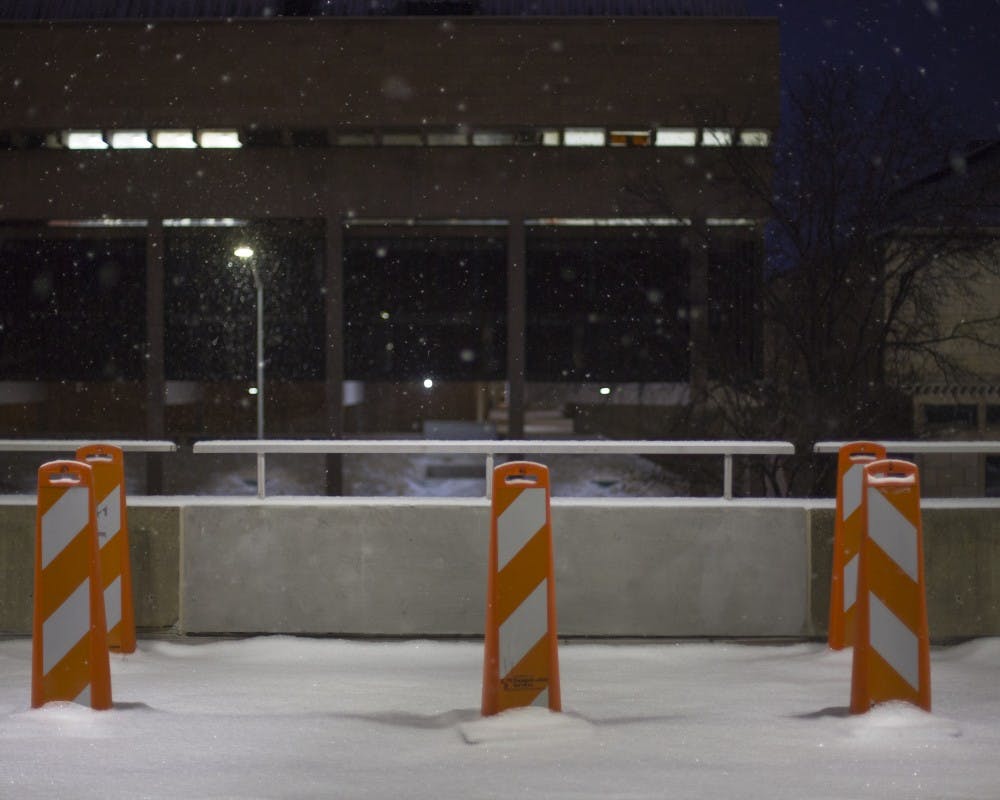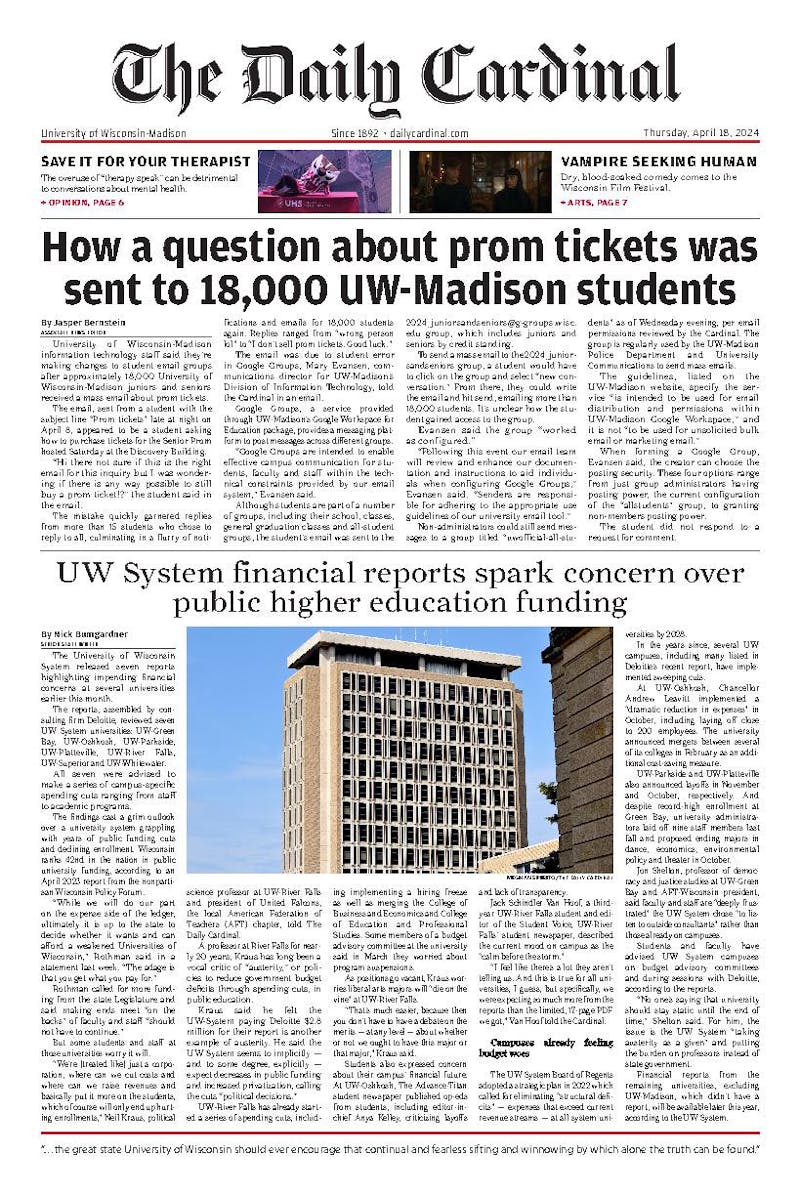Roughly a year after Gov. Scott Walker proposed nearly $300 million in cuts to the UW System, along with significant changes to the way public higher education functions, UW-Madison associate professor David Vanness said he notices things on campus do not shine as brightly as they used to.
Vanness, also the president of the UW-Madison chapter of the American Association of University Professors, said faculty members who work in older areas of campus have seen increasing infrastructural issues.
“Over the years, our existing buildings are falling into disrepair,” Vanness said. “I’ve seen a lot of leaky roofs that don’t get fixed, a lot of things that don’t really put our best foot forward.”
Effects of the cuts extend far beyond leaky roofs, however.
Wisconsin’s 2015-’17 biennial budget allocated zero dollars to the General Fund Supported Borrowing for the State Commission All Agency Program, resulting in an approximately $100 million UW System deficit in funding for facility maintenance and infrastructure upkeep, according to a UW-Madison 2015 Budget Reduction Report.
UW-Madison Chancellor Rebecca Blank said in a recent address to the UW System Board of Regents that although complete data has not yet been collected on the most recent round of cuts, Wisconsin is still one of the only states that has declined in support for higher education.
Blank said the cuts have been particularly challenging for faculty retainment, because competing state universities across the country have started using their increased investment to recruit UW-Madison’s “best faculty.”
According to Blank, 85 percent of faculty who have recently received outside offers have been retained and further efforts to prevent this type of raiding will be necessary, but costly.
“Altogether, it’s cost me $8 million in the last six months to achieve that type of success,” Blank said. “This is going to cost more. I can’t afford not to do this; this is the reputation of the university.”
However, unfilled positions for faculty and staff on campus remain a general concern, said Noel Radomski, director and associate researcher of the Wisconsin Center for the Advancement of Postsecondary Education.
The computer science and engineering departments have struggled, according to Radomski. The student demand for those particular programs have increased, while budget cuts resulted in a loss of faculty members and a decrease in specialized classes offered.
According to the budget reduction report, UW-Madison’s largest college, Letters and Science, will eventually see 48 faculty positions and 44 academic staff positions cut.
Additionally, the College of Agricultural and Life Sciences saw faculty departures and vacancies that cost the school an estimated $28 million in outside research funding.
Other UW departments face similar problems and have had to reduce the number and frequency of courses offered; Radomski said he believes such cuts could impact students’ time to degree completion.
The decline in state funding for higher education also affects the UW System’s approach to generating and distributing financial aid to students.
“By the choice of the governor and legislature, the costs [of a university education] are being pushed onto the student,” Radomski said. “And because of that, we’re becoming more of a private university.”
Although tuition was frozen for the second time in last year’s biennial budget, Radomski said there was no state increase in financial aid, and living costs are rising, causing more students to take out loans.
According to Radomski, private universities relying on donors and endowments to recruit students is a challenge UW-Madison has not faced before, as the university had previously been funded almost 70 percent by the state.
Radomski speculated UW schools will have to increase institutional scholarships and decide whether more of those scholarships should be need-based or merit-based, depending on what types of students they want to recruit.
Beyond the monetary cuts to the system, Walker’s originally proposed legislation included changing the Wisconsin Idea to replace core missions, like pursuing truth and improving the human condition with “to meet the state’s workforce needs.”
Amid statewide backlash, Walker called the change a “drafting error” and the original Wisconsin Idea went untouched.
However, Vanness said he thinks Walker’s focus on reorienting higher education toward workforce development is an idea still very much in play.
As universities look to reallocate funds after budget shortfalls, Vanness expressed concern as to whether those funds will be moved toward programs with direct workforce marketability and away from the liberal arts, which he said would affect students’ access to a “critical aspect of the college experience.”
“If we lose access to languages and language arts, if we lose access to philosophy, if we lose access to basic mathematics and mathematical theory—all things that don’t have direct market applicability,” Vanness said, “I think our students are robbed of the potential to achieve all that they can achieve as human beings.”
Alex Hummel, associate vice president for communications for the UW System, said several campuses have taken significant steps to manage budget reductions and will implement further steps in the months to come.
However, Radomski worries about what the next biennial budget will bring, particularly for other UW institutions that lack the reserves and alternative revenue sources UW-Madison has.
“It’s those institutions that I fear for the students,” Radomski said. “The students are going to be impacted, so too will the faculty, but it's going to be the students that are going to be hit so hard.”
Blank told the Regents UW-Madison has cut or redirected $34 million for fiscal year 2016 and tried to focus most of its larger reductions away from educational programs.
However, Blank said as the cuts continue in the months ahead, everyone at the university will feel them.
“We prioritized trying to cut administrative units a little bit more highly than educational units, we’ve given differential cuts to different programs in terms of our own prioritization,” Blank said. “But at the end of the day, you can’t take these sort of cuts without affecting every single unit across campus.”






